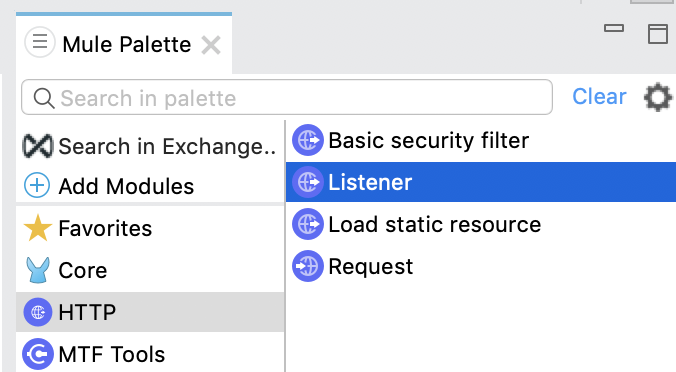
Workday Connector 14.1 Examples
Anypoint Connector for Workday (Workday Connector) provides two financial management services examples that enable you to see how to configure Workday Connector using Anypoint Studio:
Add a Fund to the Workday Financial Management Service (Studio Example)
This example uses the Invoke operation to insert a fund in the Workday financial management service.
Configure HTTP Listener
Configure HTTP Listener to initiate a Mule flow when a call is made to the / account path on localhost, port 8081.
This example uses variables for some field values. You can either:
-
Replace the variables with their values in the code.
-
Provide the values for each variable in a properties file and then refer to that file from the connector configuration.
If you don’t know how to use a properties file, see Configuring Property Placeholders.
To configure HTTP Listener:
-
Create a new Mule project in Studio.
-
In the Mule Palette view, search for
httpand select the Listener operation:Select the Listener operation in the Mule Palette view.
-
Drag the Listener operation onto the canvas.
-
In the Listener configuration, click + next to the Connector configuration field to add a global element.
-
Click OK to accept the defaults.
-
Set the Path field to
/: Figure 1. Set the Path field in the Listener configuration.
Figure 1. Set the Path field in the Listener configuration.
Add a Transform Message Component to Attach the Metadata
To add and configure a Transform Message component:
-
In the Mule Palette view, search for
transformand select Transform Message: Figure 2. Select Transform Message in the Mule Palette view.
Figure 2. Select Transform Message in the Mule Palette view. -
Drag the Transform Message component onto the canvas, to the right of the Listener component.
-
In the Transform Message configuration, overlay the brackets in the Output section with this XML:
%dw 2.0 output application/xml ns ns0 urn:com.workday/bsvc --- { ns0#Put_Fund_Request @(ns0#Add_Only: true, ns0#version: "v36.0"): { ns0#Fund_Data: { ns0#Fund_Name: "I.M.F", ns0#Fund_Type_Reference: { ns0#ID @(ns0#'type': 'Fund_Type_ID'): "FUND_TYPE-6-3" } } } }
The following XML shows sample input to the Transform Message component
<ns0:Put_Fund_Request xmlns:ns0="urn:com.workday/bsvc" Add_Only="true" version="v36.0">
<ns0:Fund_Data>
<ns0:Fund_Name>I.M.F</ns0:Fund_Name>
<ns0:Fund_Type_Reference>
<ns0:ID type="Fund_Type_ID">FUND_TYPE-6-3</ns0:ID>
</ns0:Fund_Type_Reference>
</ns0:Fund_Data>
</ns0:Put_Fund_Request>The following screenshot shows the corresponding output, as it appears in the Output section of the Transform Message configuration:

Add and Configure the Financial Management Operation
-
In the Mule Palette view, search for
workdayand select the Financial management operation. -
Drag the Financial management operation onto the canvas, to the right of the Transform Message component.
-
In the Financial management configuration, click + next to the Connector configuration field to add a global element.
-
Configure the global element as follows:
-
Configuration Name:
My_Workday_Connection -
Connection:
Basic authentication api -
Password:
${workday.password} -
Host Name: Leave the default,
impl-cc.workday.com -
Tenant Name:
${workday.tenantName} -
Username:
${workday.userName}
-
-
Click Test Connection to ensure your username, password, and tenant name are correct.
-
Click OK.
-
In the properties window, select
Put_Fundin the Operation field.
Add a Logger Component to Display the Response in the Mule Console
-
In the Mule Palette view, search for
loggerand select Logger (Core). -
Drag the Logger component onto the canvas, to the right of the Financial management component.
-
Configure the following fields:
Field Value Display Name
Enter
Log Response.Message
Enter
`#[payload]`.Level
Leave the default,
INFO. -
Save the project.
-
Test the app by sending a request to
/on port 8081. -
You will receive an XML response similar to this one:
<wd:Put_Fund_Response xmlns:wd="urn:com.workday/bsvc" wd:version="v36.0">
<wd:Fund_Reference wd:Descriptor="I.M.F">
<wd:ID wd:type="WID">THE_WID_ID_NUMBER</wd:ID>
<wd:ID wd:type="Fund_ID">FUND-6-399</wd:ID>
</wd:Fund_Reference>
</wd:Put_Fund_Response>XML for the Financial Management Example
Paste this code into the Studio XML editor to quickly load the flow for this example into your Mule app:
?xml version="1.0" encoding="UTF-8"?>
<mule xmlns:ee="http://www.mulesoft.org/schema/mule/ee/core" xmlns:http="http://www.mulesoft.org/schema/mule/http"
xmlns:workday="http://www.mulesoft.org/schema/mule/workday"
xmlns="http://www.mulesoft.org/schema/mule/core" xmlns:doc="http://www.mulesoft.org/schema/mule/documentation" xmlns:xsi="http://www.w3.org/2001/XMLSchema-instance" xsi:schemaLocation="http://www.mulesoft.org/schema/mule/core http://www.mulesoft.org/schema/mule/core/current/mule.xsd
http://www.mulesoft.org/schema/mule/workday http://www.mulesoft.org/schema/mule/workday/current/mule-workday.xsd
http://www.mulesoft.org/schema/mule/http http://www.mulesoft.org/schema/mule/http/current/mule-http.xsd
http://www.mulesoft.org/schema/mule/ee/core http://www.mulesoft.org/schema/mule/ee/core/current/mule-ee.xsd">
<http:listener-config name="HTTP_Listener_config" doc:name="HTTP Listener config" >
<http:listener-connection host="0.0.0.0" port="8081" />
</http:listener-config>
<workday:config name="My_Workday_Connection" doc:name="Workday Config" >
<workday:basic-authentication-api-connection password="${workday.password}" tenantName="${workday.tenantName}" userName="${workday.userName}" />
</workday:config>
<http:listener-config name="HTTP_Listener_config1" doc:name="HTTP Listener config" >
<http:listener-connection host="0.0.0.0" port="8081" />
</http:listener-config>
<workday:config name="My_Workday-Connection" doc:name="Workday Config" >
<workday:basic-authentication-api-connection password="${workday.password}" tenantName="${workday.tenantName}" userName="${workday.userName}" />
</workday:config>
<flow name="workday-13-test-exampleFlow" >
<http:listener doc:name="Listener" config-ref="HTTP_Listener_config1" path="/"/>
<ee:transform doc:name="Transform Message" >
<ee:message >
<ee:set-payload ><![CDATA[%dw 2.0
output application/xml
ns ns0 urn:com.workday/bsvc
---
{
ns0#Put_Fund_Request @(ns0#Add_Only: true, ns0#version: "v36.0"): {
ns0#Fund_Data: {
ns0#Fund_Name: "I.M.F",
ns0#Fund_Type_Reference: {
ns0#ID @(ns0#'type': 'Fund_Type_ID'): "FUND_TYPE-6-3"
}
}
}
}]]></ee:set-payload>
</ee:message>
</ee:transform>
<workday:financial-management doc:name="Financial management" config-ref="My_Workday-Connection"/>
<logger level="INFO" doc:name="Log Response" message="#[payload]"/>
</flow>
</mule>


